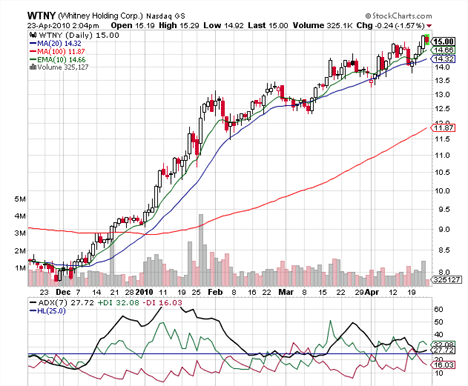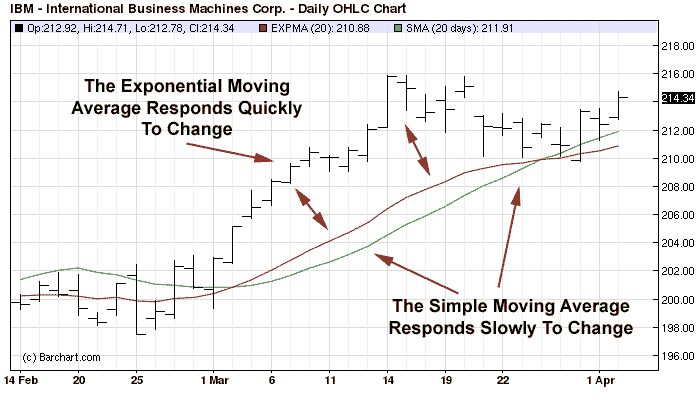Trading Volatile Stocks with Technical Indicators
Post on: 9 Июнь, 2015 No Comment

Volatility is the dispersion of returns for a given security or market index. It is quantified by short-term traders as the average difference between a stocks daily high and daily low, divided by the stock price. A stock that moves $5 per day with a $50 share price is more volatile than a stock that moves $5 per day with a $150 share price, because the percentage move is greater with the first. Trading the most volatile stocks is an efficient way to trade, because theoretically these stocks offer the most profit potential. Not without their own dangers, many traders seek out these stocks but face two primary questions: How to find the most volatile stocks, and how to trade them using technical indicators? (See The Four Most Commonly-Used Indicators for Trend Traders .)
How to Find the Most Volatile Stocks
Finding the most volatile stocks isn’t complex, and doesn’t require constant research or stock screening. Instead, run a stock screen for stocks that are consistently volatile. Volume is also essential when trading volatile stocks, for entering and exiting with ease.
Stock Fetcher (StockFetcher.com ) is an example of a filter you can use to track very volatile stocks:
Applying the above filters, Stock Fetcher will pick stocks with average moves greater than 5% per day (between the open and close) over the last 100 days. It also filters stocks priced between $10 and $100 and with average daily volume of over 4 million in the last 30 days. Furthermore, if you are only interested in stocks, adding a filter like exchange is not Amex helps avoid leveraged ETFs appearing in the search results.
A more research-intensive option is to look for volatile stocks each day. Finviz.com (free version) provides top gainers, top losers and the most volatile stocks for each trading day. Use the screener tool to further filter results for market capitalization, performance and volume. Narrowing the search in this fashion provides traders with a list of stocks matching their exact specifications.
Nasdaq.com lists the biggest gainers and losers on the NASDAQ. NYSE and AMEX. These are not filtered results, and only reflect volatility for that day. Therefore, the list provides potential stocks which could continue to be volatile. but traders needs to go through the results manually and see which stocks have a history of volatility and have enough volume to warrant trading.
Trading the Most Volatile Stocks
Volatile stocks are prone to sharp moves, which requires patience in awaiting entries, but quick action when those entries appear. As with any stock, trading volatile stocks that are trending provides a directional bias giving the trader an advantage. Certain indicators can be used to trade volatile stocks but the trader must also monitor price action—watching if the price is making higher swing highs or lower swing lows relative to prior waves—to determine when indicator signals are taken, and when they are left alone. Here are two technical indicators you can use to trade volatile stocks, along with what to look for in regards to price action.
Keltner channels put an upper, middle and lower band around the price action on a stock chart.
The indicator is most useful in strongly trending markets when the price is making higher highs and higher lows for an uptrend, or lower highs and lower lows for a downtrend.
During a strong uptrend the price will ride the upper Keltner channel and pullbacks will often barely reach the middle band, and not exceed the lower band. The mid-band is therefore a potential entry point. A stop is placed roughly half to two-thirds of the way between the mid-band and the lower band. An exit is placed just above the upper band.
Apply the same concept to downtrends. The price often tracks the lower Keltner channel line and pullbacks will often reach the middle band but not exceed the upper Keltner line. The middle line therefore provides a short-entry area, a stop is placed just inside the upper Keltner line and a target is below the lower Keltner line.
Keltner channels are typically created using the previous 20 price bars, with an Average True Range Multiplier to 2.0. The reward relative to risk is usually 1.5 to 2.0 to 1; meaning for $1 of risk the profit potential is $1.50 to $2.00.
Figure 1. Keltner Channels (20, 2.0 ATR) Applied to Yelp (YELP ) 2-Minute Chart
Since Keltner Channels move as the price moves, the target is placed at the time of the trade and kept there.
The advantage of this strategy is that an order is waiting at the middle band. Timing the entry isn’t required, and once all the orders are placed the trader doesn’t need to do anything except sit back and wait for either the stop or target to be filled. Alternatively, the trade can be actively managed. For a very strong trend, the target can be adjusted to capture more profit. The stop and risk should only be reduced as the trade becomes profitable; risk is never increased during a trade.
The disadvantage of this strategy is that it works well in trending markets, but as soon as the trend disappears losing trades will commence since the price is more likely to move back and forth between the upper and lower channel lines.
Filtering trades based on the strength of the trend helps in this regard. For example, during an uptrend, if the price failed to make a higher high just before a long entry, avoid the trade as a deeper pullback is likely to stop-out the trade.
Figure 2. Keltner Channels (20, 2.0 ATR) Applied to Yelp 2-Minute Chart
Source: FreeStockCharts.com
Stochastic oscillator
The Stochastic Oscillator is another indicator which is useful for trading the most volatile stocks. This strategy utilizes the Stochastic Oscillator on ranging stocks, or stocks which lack a well-defined trend. Volatile stocks often settle into a range before deciding which direction to trend next.
Since a strong move can create a large negative position quickly, waiting for some confirmation of a reversal is prudent. The stochastic Oscillator provides this confirmation.
When the price lacks clear direction, and is moving predominantly sideways, sell near the top of the range once the Stochastic moves above 80 and then drops back below. Place a stop just above the high that just formed with a target at 75% of the way down the range. For example, if the range is $1 high, from low to high, place a target $0.25 above the low.

Take long positions near the bottom of the range when the Stochastic drops below 20 and then rallies above it. Place a stop below the recent low and target 75% up the range. If the range is a $1 high, from high to low, the target is placed $0.25 below the high.
Trades are taken as soon as the price crosses the Stochastic trigger level (80 or 20). Do not wait for the price bar to complete; by the time a 1-minute, 2-minute or 5-minute bar completes the price could run too far toward the target to make the trade worthwhile.
Ignore contrary signals while in a trade; allow the target or stop to get hit. Once the target is hit, if the stock continues to range, a signal in the opposite direction will develop shortly after. Figure 3 shows a short trade, followed immediately by a long trade, followed by another short trade.
The Stochastic Oscillator uses standard settings of 12 periods and the %K set at 3.
Figure 3. Stochastic Applied to GT Advanced Technologies (GTAT ) 2-Minute Chart
Source: FreeStockCharts.com
In figure 3 the range is $0.16 in height ($16 minus $15.84); 25% of $0.16 is $0.04. Deduct $0.04 from the high of range at $16 to get a target for long positions of $15.96. Add $0.04 to the low of the range at $15.84 to get a target for short positions of $15.88. While the range is in effect, these are your targets for long and short positions. This way the target is more likely to get hit even if the price doesn’t make it all the way back to the top or bottom of the range, when long or short respectively.
For the first short trade, just after 1:30 PM, the Stochastic rises above 80. and then drops below it. This signals a short trade. Sell at the current price as soon as the indicator crosses below 80 from above. Immediately place a stop above the recent price high that just formed. Set your exit target at $15.88. Do nothing else until either the stop or target is reached. The target is hit less than an hour later, getting you out of the trade with a profit. The Stochastic has since dropped below 20, so as soon as it rallies back above 20 enter a long trade at the current price. Quickly place a stop below the price low that just formed and place a target to exit at $15.96. This trade lasts for about 15 minutes before reaching the target for a profitable trade. Another short trade develops immediately after the prior trade; enter short at the current price as the Stochastic crosses below 80, place a stop above the recent price high and place a target to exit at $15.88. The target is reached less than 30 minutes later.
The advantage of this strategy is that it waits for a pullback to an advantageous area, and the price is starting to move back in our trade direction when we enter. Therefore a relatively tight stop can be used, and the reward to risk ratio will typically be 1.5:1 or greater.
The main disadvantage is false signals. False signals are when the indicator crisscrosses the 80 line (for shorts) or 20 line (for longs), potentially resulting in losing trades before the profitable move develops.
Since the Stochastic moves slower than price, the indicator may also provide a signal too late. When the entry signals occurs the price may have already moved significantly toward the target, thus reducing the profit potential and possibly making the trade not worth taking. Upon entry, the reward should be at least 1.5 times greater than the risk, based on the target and stop.
The Bottom Line
Volatile stocks are attractive to traders because of the quick profit potential. Trending volatile stocks often provide the greatest profit potential, as there is a directional bias to aid the traders in making decisions. Keltner channels are useful in strong trends because the price often only pulls back to the middle band, providing an entry. The downside is that once the trend ends losing trades will occur. Monitoring price action and making sure the price is making a higher high and higher low before entering an uptrend trade (lower low and lower high for downtrend trade) will help mitigate this defect. Volatile stocks don’t always trend; they often whip back and forth. During a range when the stochastic reaches an extreme level (80 or 20) and then reverses back the other way it indicates the range is continuing and provides a trading opportunity. Monitor both the stochastic and Keltner channels to act on either trending or ranging opportunities. No indicator is perfect though, therefore always monitor price action to help determine when the market is trending or ranging so the right tool is applied.














